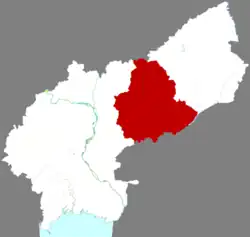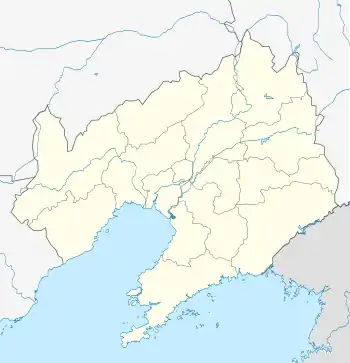Beizhen
北镇市 | |
|---|---|
 Location in Jinzhou | |
 Beizhen Location in Liaoning | |
| Coordinates: 41°36′N 121°48′E / 41.600°N 121.800°E | |
| Country | People's Republic of China |
| Province | Liaoning |
| Prefecture-level city | Jinzhou |
| Area | |
| • County-level city | 1,782.0 km2 (688.0 sq mi) |
| • Urban | 78.80 km2 (30.42 sq mi) |
| Elevation | 64 m (210 ft) |
| Population (2017)[1] | |
| • County-level city | 495,000 |
| • Density | 280/km2 (720/sq mi) |
| • Urban | 154,800 |
| Time zone | UTC+8 (China Standard) |
Beizhen (simplified Chinese: 北镇; traditional Chinese: 北鎭; pinyin: Běizhèn) is a city in west-central Liaoning province of Northeast China. It is under the administration of Jinzhou City.
History
In 1123, the Jin Dynasty set Guangning County (Chinese: 廣寧縣) in nowadays Beizhen. In Ming Dynasty, the town of Guangning became a base of the Ming troops in Liaotung and a prosperous border trading center. In 1913, the name was changed to Beizhen, which is an alternative name of the Yiwulü Mountain, literally meaning "the guarding mountain of the North".[2] In 1995, Beizhen County became Beining City (北寧市), the name of which is later changed to the current name.
Administrative divisions

There are three subdistricts, 14 towns, and six townships under the city's administration.[3]
Subdistricts:
- Beizhen Subdistrict (北镇街道), Guangning Subdistrict (广宁街道), Guanyin'ge Subdistrict (观音阁街道)
Towns:
- Dashi (大市镇), Zheng'an (正安镇), Zhong'an (中安镇), Luoluobao (罗罗堡镇), Changxingdian (常兴店镇), Lüyang (闾阳镇), Goubangzi (沟帮子镇), Liaotun (廖屯镇), Qingduizi (青堆子镇), Gaoshanzi (高山子镇), Zhaotun (赵屯镇)
Townships:
- Futun Township (富屯乡), Baojia Township (鲍家乡), Datun Township (大屯乡), Liujia Township (柳家乡), Wucheng Township (吴家乡), Liaocheng Township, Beizhen (辽城乡)
Climate
| Climate data for Beizhen (1991–2020 normals) | |||||||||||||
|---|---|---|---|---|---|---|---|---|---|---|---|---|---|
| Month | Jan | Feb | Mar | Apr | May | Jun | Jul | Aug | Sep | Oct | Nov | Dec | Year |
| Mean daily maximum °C (°F) | −3.0 (26.6) |
1.1 (34.0) |
8.0 (46.4) |
16.8 (62.2) |
23.6 (74.5) |
26.9 (80.4) |
28.7 (83.7) |
28.5 (83.3) |
24.7 (76.5) |
16.9 (62.4) |
6.4 (43.5) |
−1.2 (29.8) |
14.8 (58.6) |
| Daily mean °C (°F) | −8.4 (16.9) |
−4.4 (24.1) |
2.4 (36.3) |
10.8 (51.4) |
17.7 (63.9) |
21.9 (71.4) |
24.5 (76.1) |
23.8 (74.8) |
18.9 (66.0) |
11.1 (52.0) |
1.3 (34.3) |
−6.2 (20.8) |
9.4 (49.0) |
| Mean daily minimum °C (°F) | −12.8 (9.0) |
−9.1 (15.6) |
−2.5 (27.5) |
5.4 (41.7) |
12.1 (53.8) |
17.2 (63.0) |
20.7 (69.3) |
19.8 (67.6) |
13.7 (56.7) |
5.9 (42.6) |
−3.1 (26.4) |
−10.4 (13.3) |
4.7 (40.5) |
| Average precipitation mm (inches) | 2.6 (0.10) |
3.2 (0.13) |
8.2 (0.32) |
26.2 (1.03) |
52.6 (2.07) |
88.3 (3.48) |
172.4 (6.79) |
142.6 (5.61) |
44.5 (1.75) |
29.6 (1.17) |
13.9 (0.55) |
2.8 (0.11) |
586.9 (23.11) |
| Average precipitation days (≥ 0.1 mm) | 1.8 | 1.9 | 3.2 | 5.3 | 8.1 | 10.5 | 10.7 | 9.8 | 5.9 | 5.0 | 3.2 | 2.0 | 67.4 |
| Average snowy days | 2.4 | 2.8 | 2.5 | 0.7 | 0 | 0 | 0 | 0 | 0 | 0.2 | 2.5 | 2.5 | 13.6 |
| Average relative humidity (%) | 48 | 46 | 43 | 45 | 52 | 68 | 79 | 77 | 64 | 56 | 52 | 50 | 57 |
| Mean monthly sunshine hours | 209.0 | 205.7 | 247.4 | 244.1 | 271.6 | 229.5 | 202.5 | 223.7 | 237.6 | 225.0 | 187.8 | 189.9 | 2,673.8 |
| Percent possible sunshine | 70 | 68 | 67 | 61 | 60 | 51 | 44 | 53 | 64 | 66 | 64 | 67 | 61 |
| Source: China Meteorological Administration[4][5] | |||||||||||||
References
- 1 2 Ministry of Housing and Urban-Rural Development, ed. (2019). China Urban Construction Statistical Yearbook 2017. Beijing: China Statistics Press. p. 50. Archived from the original on 18 June 2019. Retrieved 11 January 2020.
- ↑ Hao Yaofu (郝瑤甫) (1984). 东北地方志考略. Liaoning People's Press (辽宁人民出版社. p. 87.
- ↑ 锦州市
- ↑ 中国气象数据网 – WeatherBk Data (in Simplified Chinese). China Meteorological Administration. Retrieved 5 October 2023.
- ↑ 中国气象数据网 (in Simplified Chinese). China Meteorological Administration. Retrieved 5 October 2023.
External links